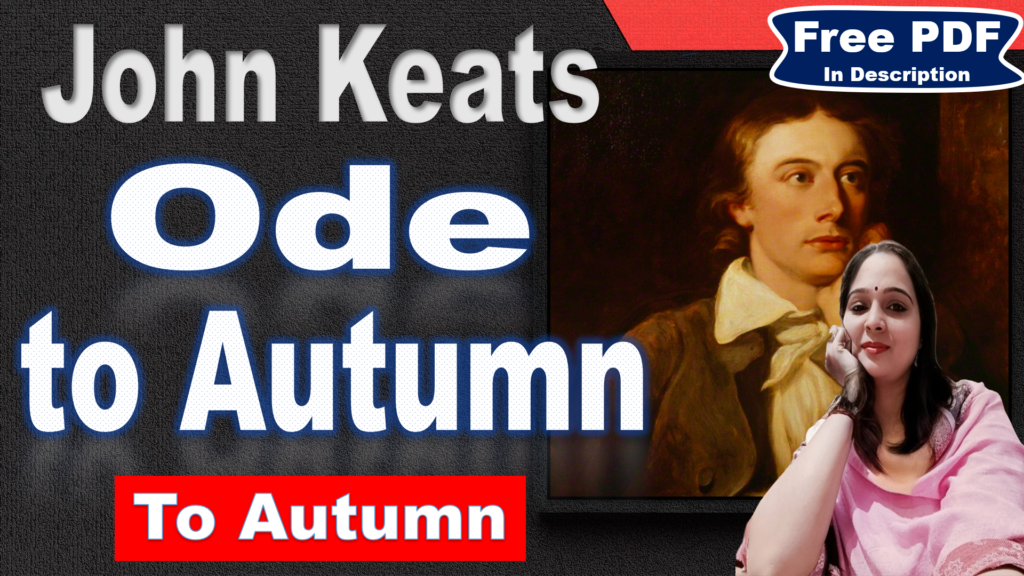
Ode to Autumn Questions and Answers
Very Short Answer Questions
Who is the author of “Ode to Autumn”?
The author of “Ode to Autumn” is John Keats.
What is the form of the poem?
The poem is an ode.
Who is the speaker in the poem?
The speaker in the poem can be considered a lyrical persona of the author himself, John Keats.
What is the setting of the poem?
The setting of the poem is during autumn.
What is the central theme of the poem?
The central theme of the poem is the beauty and transience of life.
What is the plot of the poem?
The poem is a tribute to autumn, discussing its richness and transition into winter.
What is the tone of the poem?
The tone of the poem is lively and appreciative.
What style is the poem written in?
The poem is written in a descriptive and vivid style.
Who are depicted as friends in the first two lines?
The maturing sun and autumn are depicted as friends in the first two lines.
What is the connection between the flowers and the bees?
Bees carry pollens from the flowers which help flowers to grow.
Why is the season of mists called the ‘close bosom-friend’ of the sun?
It helps the sun in replenishing nature and ripening of the fruits and growth of vegetables.
How do the season of mist and the sun conspire?
They conspire to load trees with fruits, fill sweetness to their core and also load creepers and vines with vegetables.
In what way has the summer helped the bees?
The summer has helped the bees to make the budding flowers bloom and produce honey in abundance.
Explain the line: “Barred clouds bloom the soft dying day, And touch the stubble plains with rosy hue.”
The poet describes the scene of the earth at sunset.
Why is the gleaner’s head said to be laden?
The gleaner’s head is laden with the leftover grains that he/she collected from the field.
Why is the Autumn said to be very careless?
By the time autumn comes, the harvest is over and grains are securely stored inside the granaries.
What is the central idea of the poem “To Autumn”?
The central idea of the poem is the beauty and transience of life.
What figures of speech are used in John Keats’ “To Autumn”?
The figures of speech used in “To Autumn” include personification, imagery, and alliteration.
How does John Keats personify autumn in “To Autumn”?
Keats personifies autumn as a harvester, a gleaner, and a musician.
Why is the poem “To Autumn” considered a Romantic poem?
The poem is considered a Romantic poem because it emphasizes emotion, individualism, and the beauty of nature.
Short Answer Questions
What is the central idea of the poem “To Autumn”?
The central idea of the poem “To Autumn” is the beauty and transience of life. The poem expresses reverence and awe for the great changes wrought by nature as autumn brings its riches to the landscape.
What figures of speech are used in John Keats’ “To Autumn”?
The figures of speech used in “To Autumn” include personification, imagery, and alliteration. The season of autumn is personified as a close friend of the sun, a harvester, a gleaner, and a musician.
How does John Keats personify autumn in “To Autumn”?
Keats personifies autumn as a harvester, a gleaner, and a musician. In the first stanza, autumn is a harvester who conspires with the sun to ripen fruits and crops. In the second stanza, autumn is a gleaner who crosses a brook and watches a cider press. In the third stanza, autumn is a musician who produces music that is pleasant to the ear.
Why is the poem “To Autumn” considered a Romantic poem?
The poem is considered a Romantic poem because it emphasizes emotion, individualism, and the beauty of nature. It reflects the Romantic era’s emphasis on expressing deep personal feelings and the beauty of the natural world.
How is nature presented in John Keats’ “To Autumn”?
Nature is presented in a very positive and beautiful light in “To Autumn”. The poem describes the richness and beauty of the season of autumn, with its ripe fruits, blooming flowers, and singing birds. It presents nature as a source of joy and inspiration.
What is the lyrical imagery in “To Autumn”?
The lyrical imagery in “To Autumn” is vivid and sensuous. Keats uses imagery to describe the sights, sounds, and sensations of autumn, such as ripe fruits, blooming flowers, singing birds, and the warmth of the sun.
What does the poet in “To Autumn” describe as the music of autumn?
The poet describes the sounds of autumn as its music. These sounds include the songs of various birds, the sound of gnats flying in the evening light, the bleating of lambs, the singing of crickets, the whistling of robins, and the chirping of swallows.
What is the significance of John Keats’ title “To Autumn”?
The title “To Autumn” signifies that the poem is an ode to the season of autumn. It suggests that the poem is a tribute to the beauty, richness, and transience of this season.
Which expressions in the first stanza of “To Autumn” indicate the season’s abundance and ripeness?
The expressions that indicate the season’s abundance and ripeness include “mellow fruitfulness”, “fill all fruit with ripeness to the core”, “to swell the gourd, and plump the hazel shells”, and “more, and still more, later flowers for the bees”.
Why is autumn called the “Season of mists and mellow fruitfulness” in Keats’ “Ode To Autumn”?
Autumn is called the “Season of mists and mellow fruitfulness” because it is a time when the weather becomes misty and the fruits ripen. The phrase “mellow fruitfulness” refers to the ripening of fruits during autumn, while “season of mists” refers to the misty weather that is typical of this season.






I want pdf of this lecture